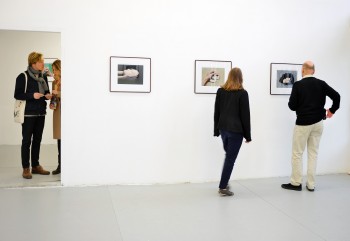
Hoaxes have long been among Aneta Grzeszykowska’s preferred artistic methods. She consistently, almost obsessively, breaks her image down into parts, either disappearing altogether or taking on an entirely different persona. The analysis of the process of self-creation – one of the most fundamental themes of art and also a basic premise for the condition of the post-medial society of today – is a major theme of her latest series of photographs.
Selfie lies between photography and sculpture. Grzeszykowska makes a radical turn in the direction of the grotesque, creating startling sculptural charades using fragments of her own body, modeled in pigskin and exhibited on smooth leather backgrounds. Her selfie takes on an uncanny quality as she creates a self-portrait out of many parts. Corporeality, sensuality and auto-eroticism are treated with sharp, black humor, which transforms the aesthetic experience into a struggle with basic existential emotions.
Once again, as with her sculptures made in wool, the artist conjures up the figure of a doll, an artificial endowed with real emotions and desire. Her refined, studied compositions refer to the world of illusion – theater and film – resembling the terrifying props of a horror film set. Grzeszykowska gracefully trespasses the bounds of convention in combining the artificial and the real. With Selfie, as in the classics of the horror genre, death imitates life, while life – the artist’s hands visible in the photographs – is deadened as she gestures towards these impermanent objects of sculpture. The fragmentation of the body, through the surreal exercise of sculpting select organs and the use of tight photographic frames, leads to a leveling of the processes of creation and destruction. Fragments of the female body are at the same time actual pieces of an animal’s flesh. Through manipulation, they all the more sharply convey the irreversibility of passing.
One of the most significant contexts of Grzeszykowska’s work is the art of Post-modern female artists, who have subject the social status of their own bodies and the cultural identity of women to verification. In subsequent works, such as Untitled Film Stills and Love Book, Grzeszykowska refers to the work of Cindy Sherman, Hannah Wilke, Ana Mendieta and other iconic representatives of Modern Art (Selfie clearly draws upon themes developed by Alina Szapocznikow, for example). The artist uses such citations and adaptations to create her own story. Her driving idea is the question of how possible it is to escape cultural and artistic stereotypes in shaping identity. In various ways Grzeszykowska takes apart her own image and manipulates the vision of her body, ultimately reaching towards a sculptural substitute. In this way she approaches the radical and jarring assertion that self-creation is merely another, imperfect means of dealing with the mortal nature of the body.
Aneta Grzeszykowska has taken part in a number of significant international exhibitions, such as the Berlin Biennial (2006), La Triennale in Paris (2012), and been exhibiting most recently at the New Museum and the Sculpture Center in New York, Contemporary Art Museum in St. Louis, Folkwang Museum in Essen and the Museum of Modern Art in Warsaw. Last year’s solo exhibition at the Zachęta – National Gallery of Art won her Polityka magazine’s Passport Prize (2014). Her works are part of numerous prestigious collections, including that of the Salomon R. Guggenheim Museum in New York, Fotomuseum Winterthur, Museum of Modern Art in Warsaw and the Łódź Art Museum.













